
A Second Chance is a short side quest I built in the Creation Kit for Fallout 4. I created it as part of my first small self-directed mod project, as I wanted to teach myself more about mission design and implementation. I designed and implemented a new NPC, a quest with dialogue and objectives, and developed two new exterior locations for the player to discover during the storyline.
Brief
This was a self-directed project to help me improve my technical knowledge of how to implement dialogue and quest mechanics in-engine. I chose to work with the Fallout 4 Creation Kit for this, despite being more experienced at working in the Skyrim Creation Kit. Fallout 4’s dialogue system often resulted in more unpredictable responses than the on-screen prompts indicate. For that reason, I wanted to dig into that system a bit more and understand how it all worked. I decided to design an NPC, create a backstory and set up a location for her in the Commonwealth. From there, the quest and additional asset requirements began to take shape. Screenshots, documentation and a breakdown of my creative process are below.
In-Game Images
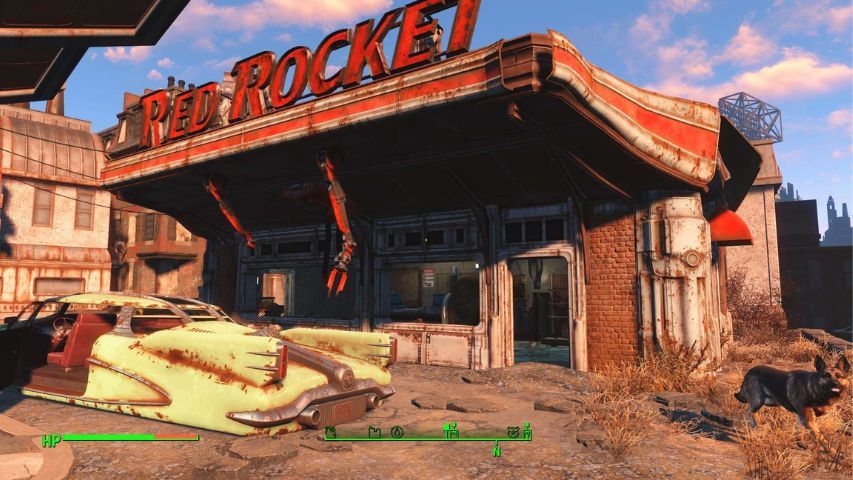
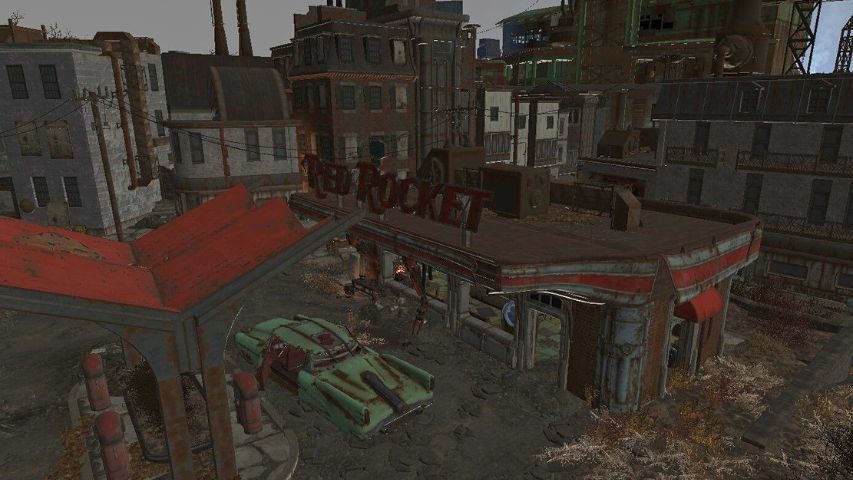
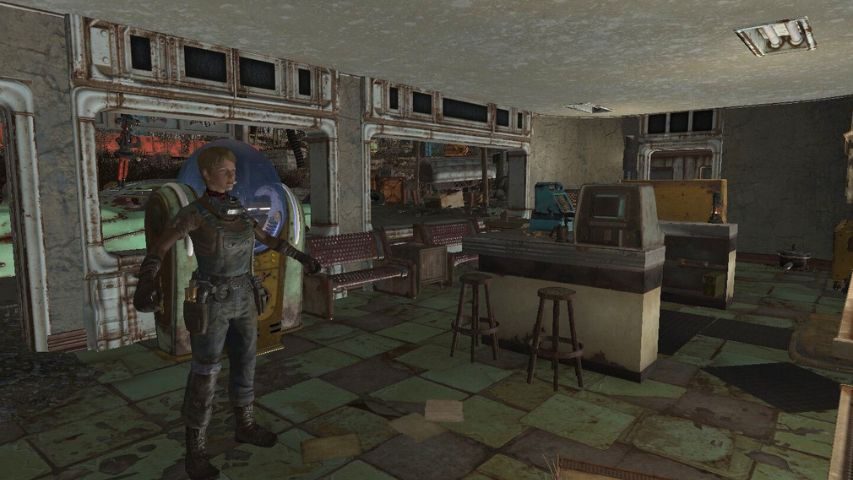
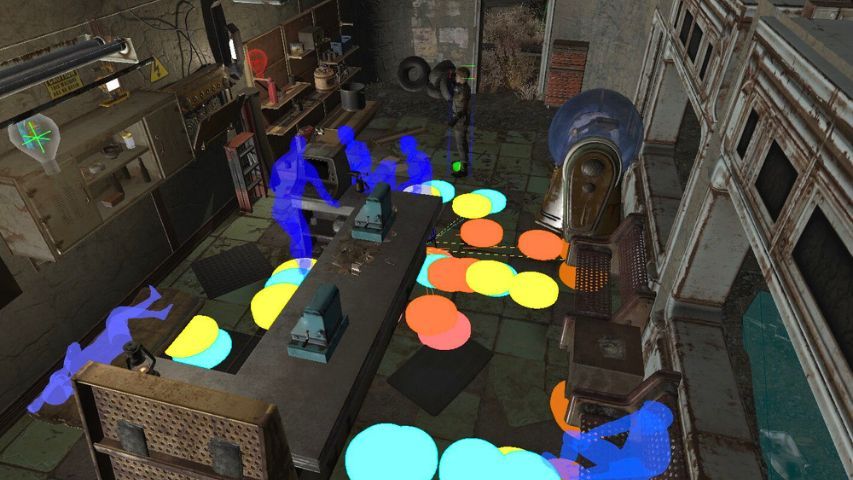
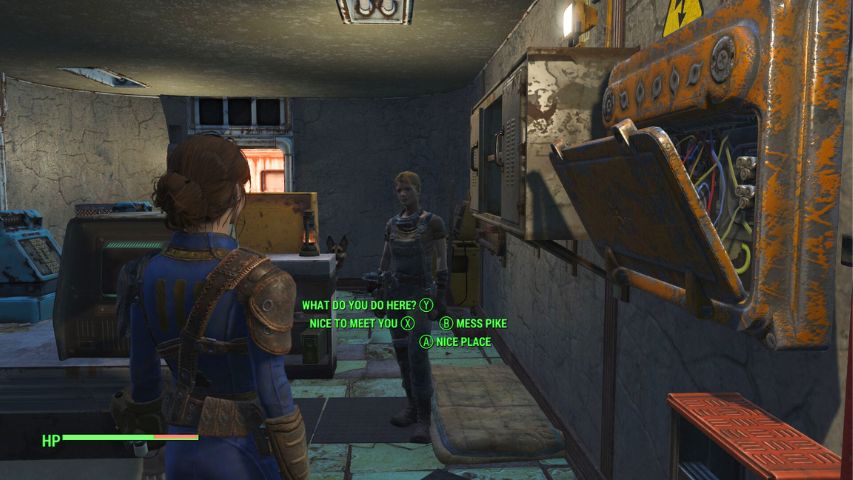
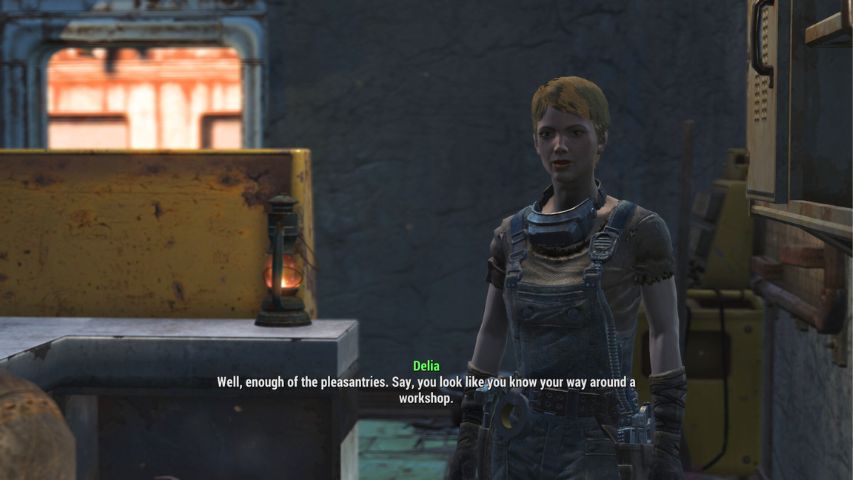
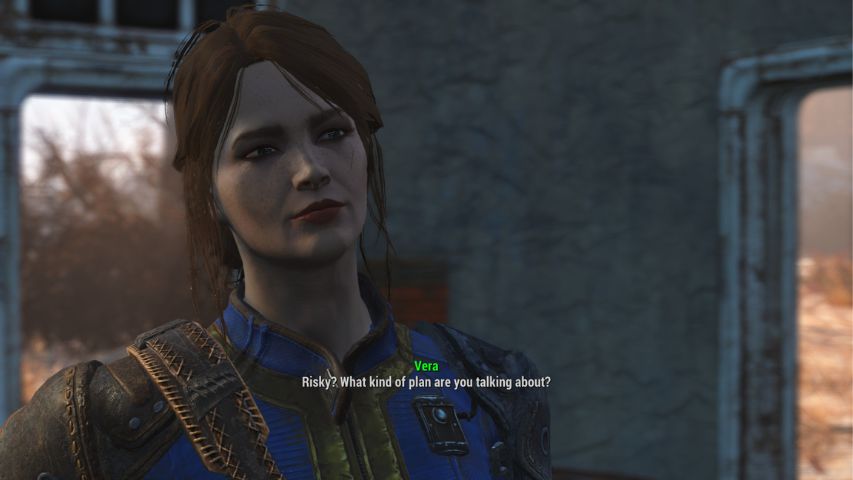
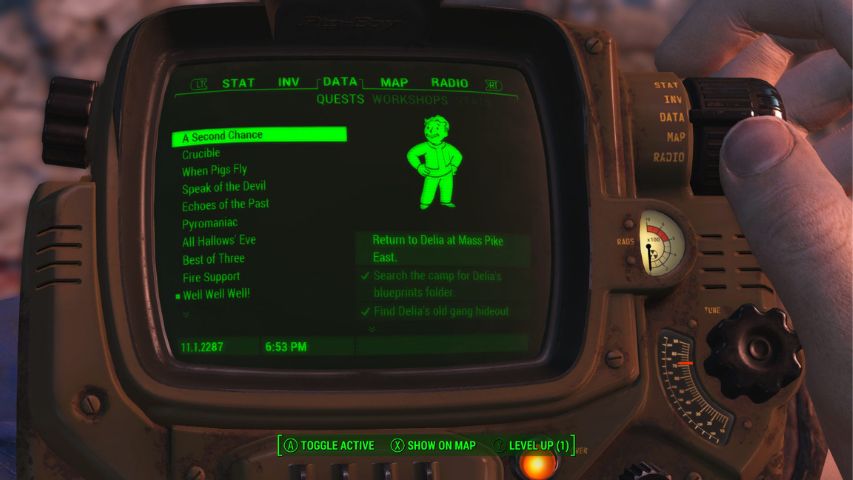
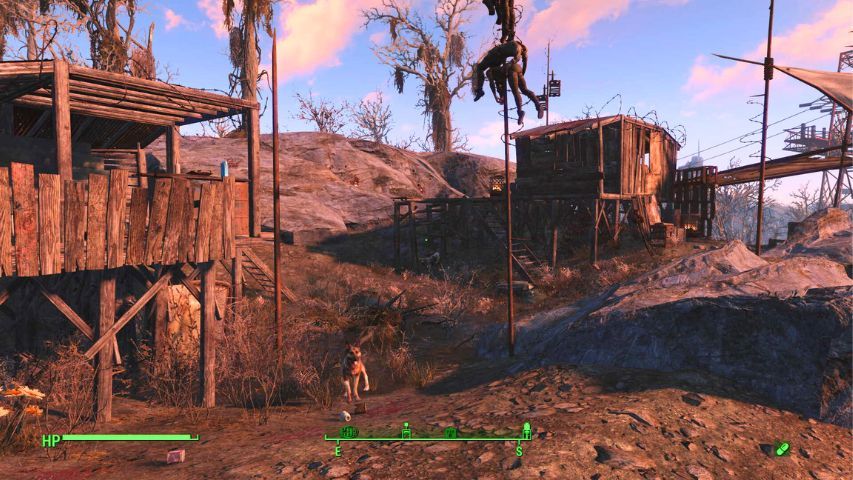
Documentation
Click here to read the NPC document for Delia Sharpe.
Click here to read A Second Chance in full (dialogue, objectives and flavor texts).
Creative Process
- Research & Ideation
- I began by drafting up concepts and by playing Fallout 4 to explore some of the game’s existing side quests. I didn’t want to make the idea too complex, as I was focused on the design processes behind the dialogue and how to make it work in-engine.
- I opted for a straightforward fetch quest that I could pack with backstory and lots of environmental storytelling through level design.
- I gave myself four constraints to help keep things within a manageable scope. The project would have one NPC, one associated questline, one lore entry or holotape and one location. I ended up with two locations and a couple of additional lore entries, but otherwise, I stuck to these guidelines.
- NPC Development
- With the basic concept for the quest in mind, I started developing its main NPC, Delia Sharpe. I listed some typical types of Fallout 4 NPC before settling on the idea of a female mechanic. I always liked the character of Sturges and thought some sort of female counterpart could be fun.
- I noted down some traits and a basic backstory before creating an NPC document to further develop her history, motivations, and personality.
- In-Engine Implementation
- With Delia’s plan in place, I started working in the Creation Kit. I’d never built an NPC before, so I used a lot of tutorial references from Bethesda’s Wiki and on YouTube to help me create the character.

Creating Delia as an NPC was a fun part of the process, and it really helped to have the clear NPC documentation I’d written available beforehand. This vastly sped up the creative process of making the character and developing her setting in the engine.
- Quest Ideation
- At this point, I refined basic quest concept I’d developed for Delia’s character. She needed an item for the player to fetch, which meant working out what that could be, why she’d need it, why she couldn’t get it herself and where the player would need to retrieve it from.
- Initially, I thought maybe she’d need some lost tools, or missing scrap parts, but that seemed too obvious. Then I thought about a folder of important schematics and how Delia might need those to ensure her ongoing safety.
- From there, I was able to devise a concept about a stolen blueprints folder that contained plans for high-tech defences. This fit with Delia’s characterisation and backstory. It also gave me the additional lore entry that I tasked myself with creating at the start.
- Set Quest Stages
- Fallout 4’s quest design system was new to me. I’d previously written quests for Skyrim mods, but I knew that the quest design template used by the Arcane University and Beyond Skyrim wouldn’t work in the same way here.
- I referred back to the Bethesda Wiki materials and YouTube tutorials to help me build my own template for documenting quest designs.
- Starting out on paper, I jotted down five basic quest stages and developed objectives for each one. With this framework in place, I started to fill in the conversational gaps between each of the stages in a way that communicated character backstory, motivation and quest purpose.
- Dialogue Writing
- My first pass at the quest dialogue gave me time to establish a four-answer player response pattern for each NPC prompt. For every conversation scene, I devised a positive, negative, neutral and question interaction for players to select from.
- The most challenging part of this was ensuring a natural flow to the dialogue, as the dialogue system works on a four-pronged prompt and response basis. This means that no matter what the player response might be, the next phase of conversation had to appear to flow seamlessly. If the player opted for a negative response, I still needed the next phase of NPC conversation to fit into that dynamic.

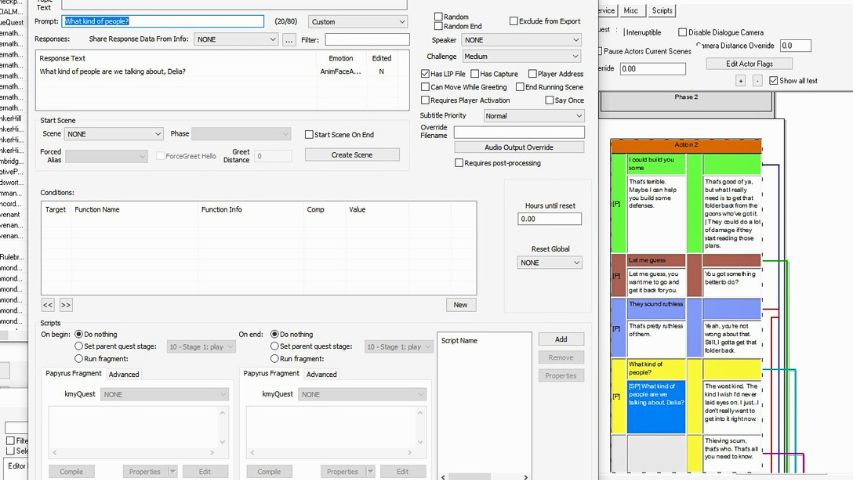
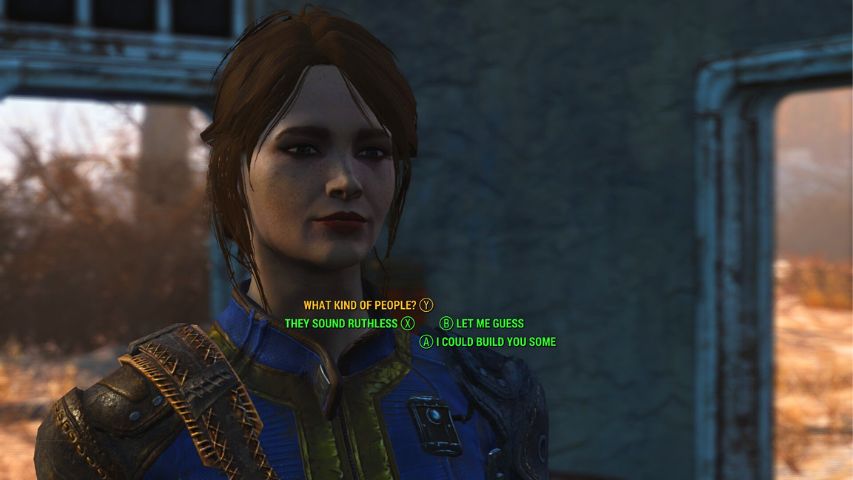
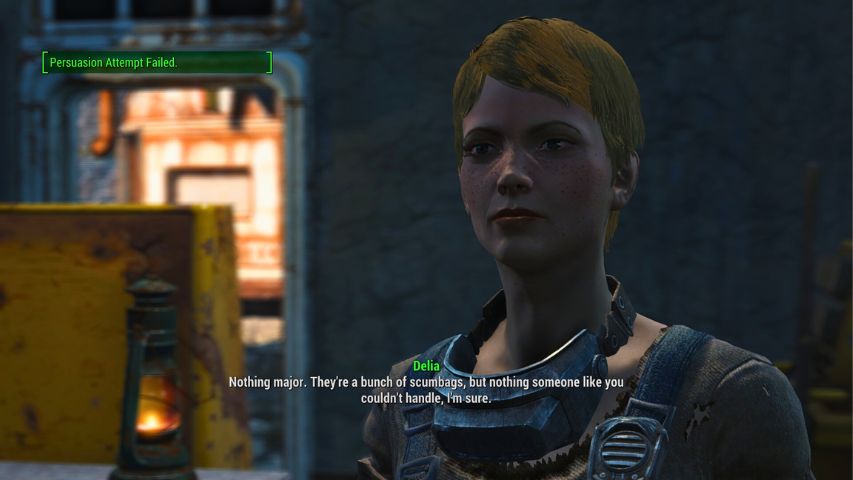
- I worked around this by developing additional scenes to compliment the ruder or more challenging response options. However, I had to make sure I did it in a way that’d bring the dialogue back to the main branch without it seeming too unrealistic.
- I also added some options for persuasion speech checks, to explore the pass and fail mechanics of the dialogue system in the Creation Kit.
- With the dialogue planned out, I implemented it into the Creation Kit by creating a new quest and adding several scenes to match up with the quest stages and objectives.
- Level Design Work
- I now knew I needed two locations; Delia’s base and a Raider camp to place the blueprints folder in. I decided to work with one existing location and then possibly build a new Raider camp in a wilderness cell somewhere in the wasteland. I’ve gone into more detail on the level design process below.
- Working on the level design alongside developing and implementing the quest in the Creation Kit was really informative. It helped me to positionally envisage the player pathway and ideate on the quest stages during the building process.
- In-Engine Quest Implementation
- With the locations built, it was time for me to fully implement all of the quest dialogue I’d previously documented. I’d broken this down into scenes, which I then populated in the Creation Kit’s quest dialogue system.
- This part of the process took a while, as I’d never done it before. However, it gave me a good insight into how to map dialogue and link it to objectives with a node-based, visual system that still left space for text input.
- The hardest bit was probably learning and implementing the fragments of Papyrus Scripting to make the quest objectives update and complete in the correct order, and to assign the player quest rewards. I got the hang of it in the end though.
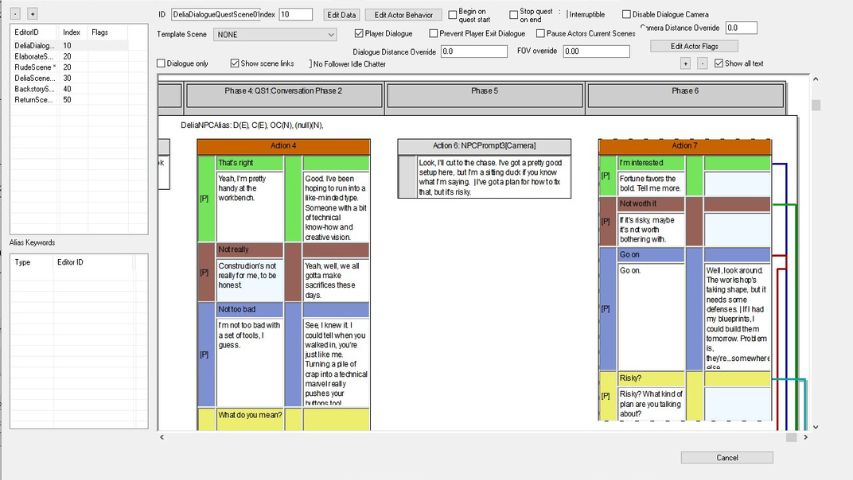
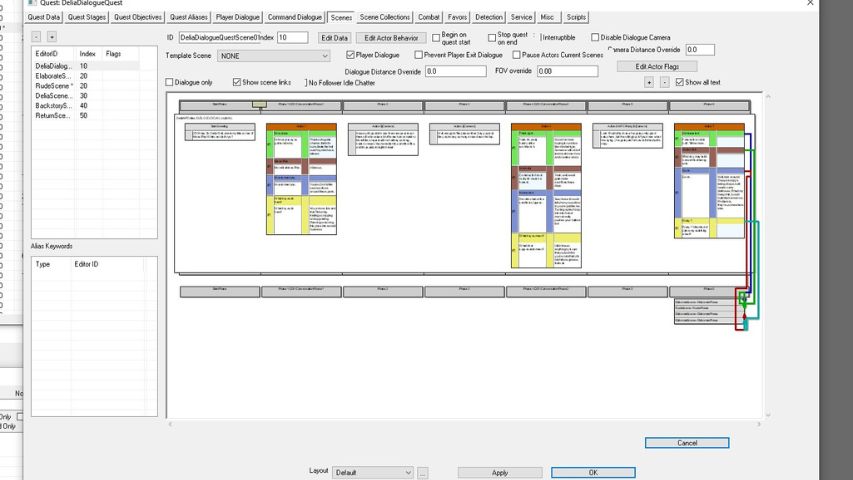
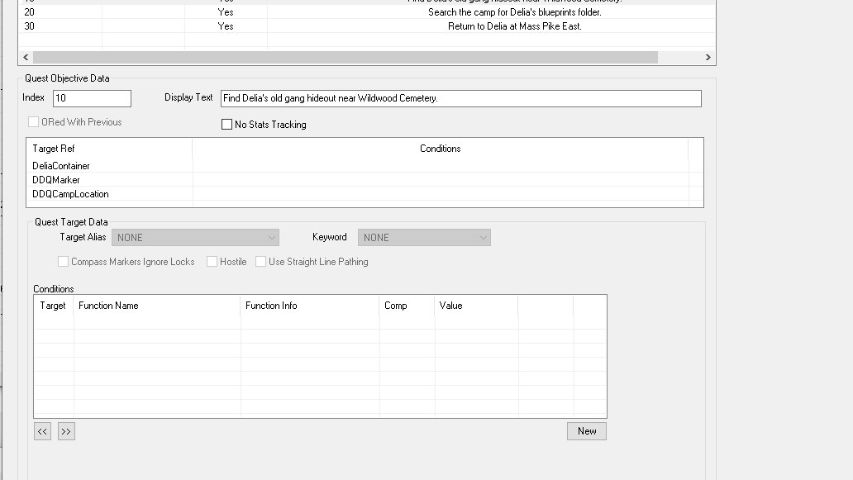
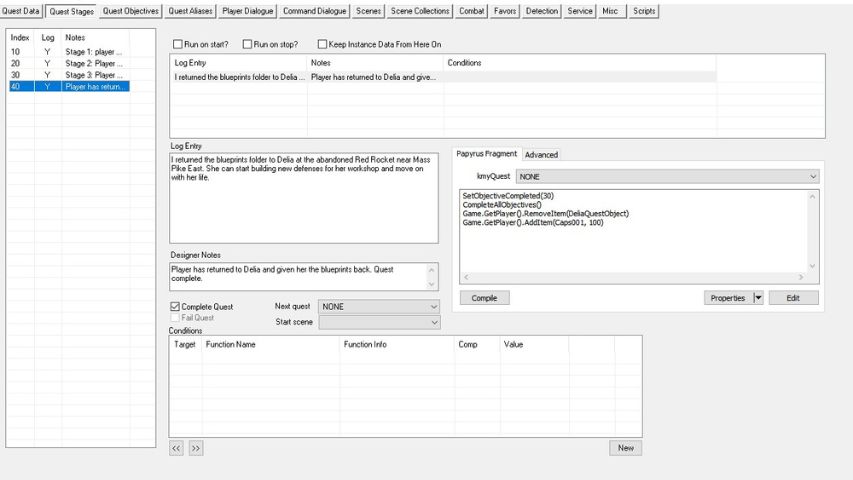
- Testing and Rewriting
- I put the quest through a lot of testing at this point! I had to ensure the dialogue was all implemented correctly and that the quest stages and objectives worked in tandem with the planned player pathway.
- There were a fair few bugs for me to go back and fix, and it was also at this point that I realised I needed to actually record some voice lines for my NPC. I wouldn’t be able to add voice lines for the player character, but Delia needed to have some kind of speech to make her dialogue work.
- Recording Voice Lines and Implementing In-Engine
- This meant I had to teach myself a number of things I’d never done before. Notably, how to do a Boston accent (being from the north-east of England, this was a bit of a challenge), and how to record voice lines for games.
- I recorded all of Delia’s dialogue in Audacity and gave myself a crash course in how to make my microphone sound a bit more professional. With varying degrees of success on that front, I then added the audio files into the quest dialogue system.
- I also had to learn how to make Delia actually voice the lines, so I installed a plugin to generate LIP files, so that Delia’s mouth would move in-sync with the audio I’d recorded.
- Once I’d done that, Delia spoke all the dialogue lines successfully in-game, albeit with my terrible attempt at a Boston accent.
- More Testing
- The mod went through more rounds of in-game testing and tweaking, until everything eventually worked as intended.
Level Design
I quickly realised I’d need to design and build two new locations for the player to discover during the quest. Delia needed a workshop to call home and there needed to be a new Raider camp for the player to track down. For the workshop, I chose an empty existing Red Rocket garage at the Mass Pike East exit of the Commonwealth. I added a functioning terminal and cluttered it accordingly, placing a workbench, tools and a sleeping bag alongside other items to make it seem lived-in. The Raider camp wasn’t as straightforward, but it gave me a chance to develop my level design skills a bit further by building something completely new.
Red Rocket Garage, Mass Pike East
- For Delia’s new base, I wanted to find a location not too far from Diamond City. The further south you go in the Commonwealth, the higher the combat difficulty becomes. As this was a side quest on a fairly average difficulty, I looked for somewhere reasonably central on the map.
- It made sense for Delia to look for a workshop, so I found an abandoned Red Rocket garage near to Mass Pike East.

To build Delia’s new base, I worked on an existing Red Rocket garage that wasn’t in-use or too close to any major combat zones near the Mass Pike East location. It was faster to use an existing asset for this part of the quest, but the Raider camp I knew I’d probably need to construct from the ground up.
- After cluttering the space accordingly and adding lighting and workbenches, I added Delia and ensured she had an AI behaviour that’d have her sandbox around the garage correctly. I tested this frequently, to ensure she could use the placed equipment correctly.
- I also took this time to add a terminal and implement some flavor text in the form of diary entries, so that the player could gather some further context on Delia and her history if they wanted to.
Camp Ruthless, Wildwood Cemetery outskirts
- I chose to construct the quest’s Raider camp from scratch, in an area of wilderness near to Wildwood Cemetery. This was probably one of the more time-consuming aspects of the project, as I hadn’t done much in the way of exterior level design before. However, it made the quest feel more authentic and gave Delia’s backstory a lot more credibility.
- Creating a new location in an exterior cell was really enjoyable, as I’d only ever worked with interiors like dungeons and houses. It also gave me some ideas for a new Ruthless faction of Fallout 4 Raiders, that I could potentially develop further quests with in future.
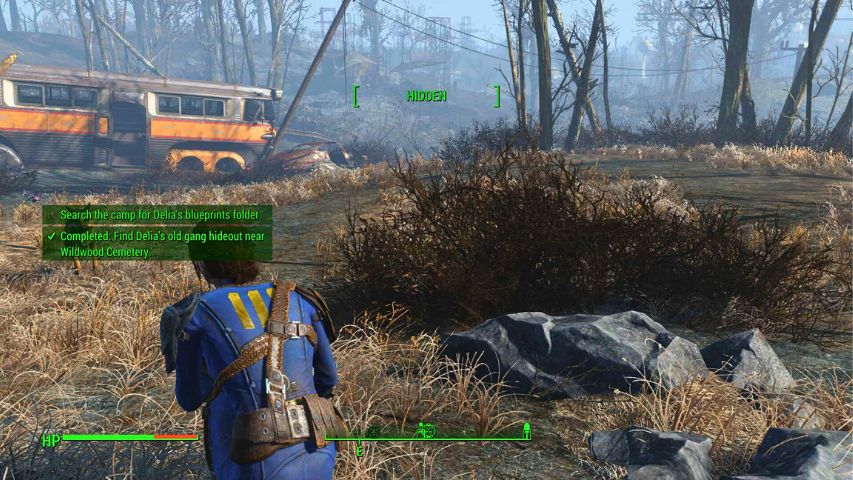
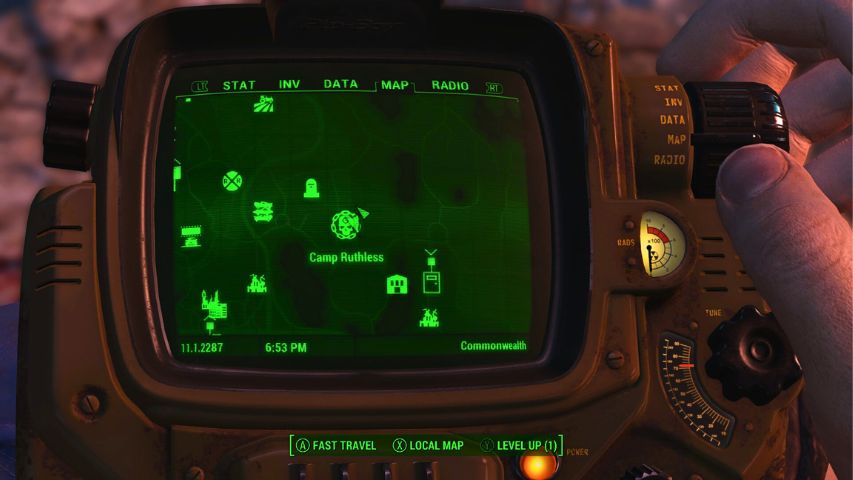
- I referred back to the tutorial materials and drew on my knowledge of working with the Skyrim Creation Kit to help me build a functioning camp. From there, I was able to include AI Raider enemy encounters and add clutter and loot, including the necessary quest item.
- Testing these enemy encounters was useful to check whether or not I’d navmeshed the area correctly and whether the enemies could patrol around the camp without any issues.
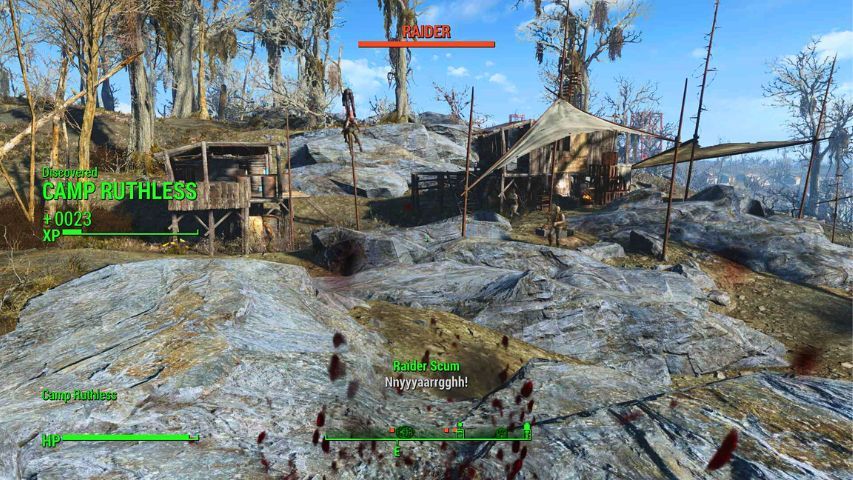

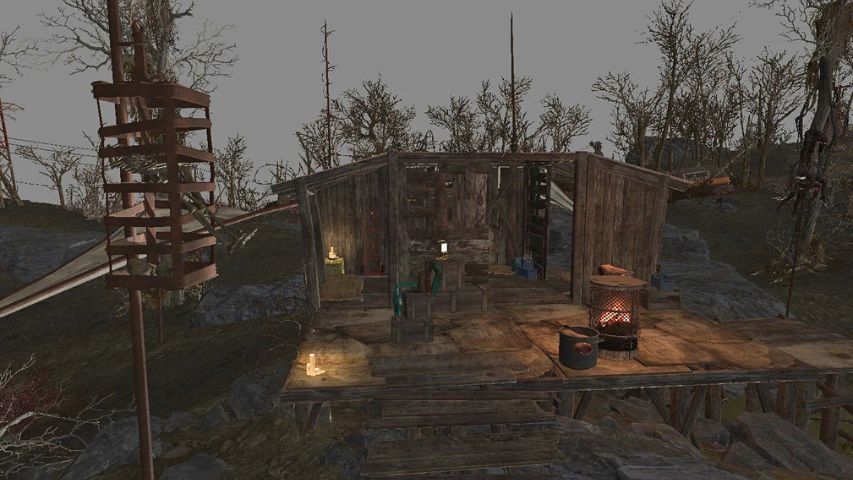
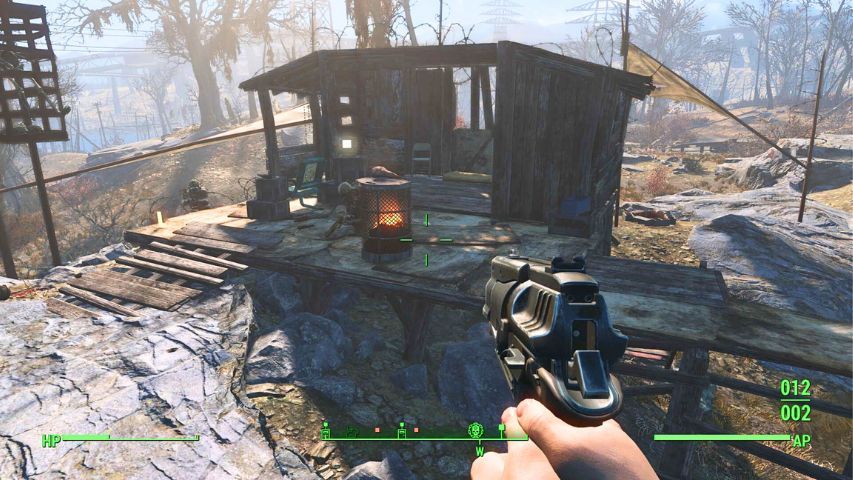
- I named the location Camp Ruthless and created a new encounter zone with location data and a trigger box for the player’s objectives to update upon finding the camp.
- Navmeshing the new cell was a bit more straightforward than in the Skyrim Creation Kit, but that could be simply because I’d had a fair bit of practice of doing it by hand at that point!
Additional Assets
- I also needed to create some additional quest assets, namely Delia’s lost book of blueprints and some journal entries to provide extra environmental storytelling via the Red Rocket terminal.
- This was fairly straightforward once I learned how to create original entries on a terminal and design a new document that players can read.

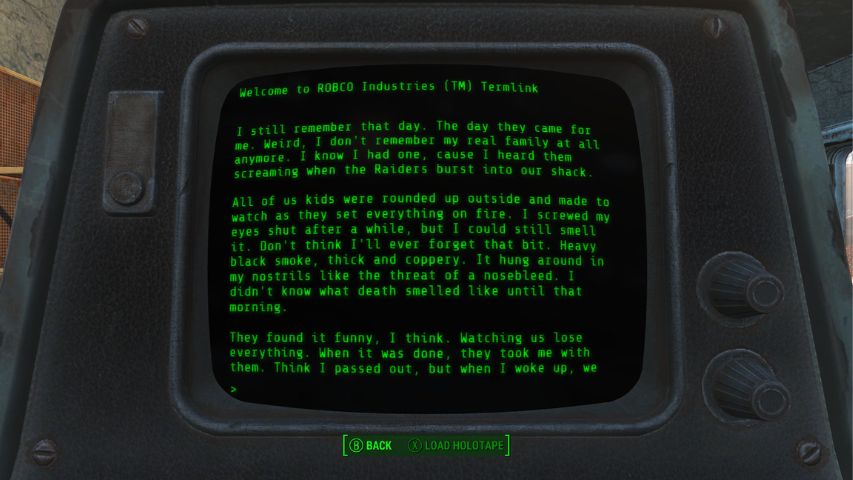
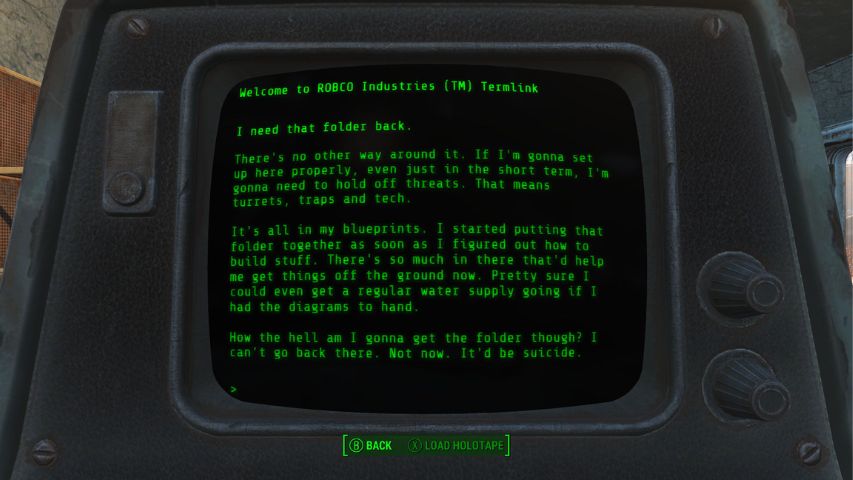

- Adding this extra bit of backstory around the quest gave things a bit more context and credibility, so that the player would understand Delia’s seemingly desperate need for someone to retrieve the blueprints on her behalf.
What This Project Taught Me
It became very clear that even when working with a fairly straightforward fetch quest, a lot of time and planning is required to bring it to life in an engine. I had to learn several new skills during the process of building this short quest mod. These included more technical aspects of quest implementation than I’d ever done before, as well as further level design work to create the desired locations and quest items.
However, in doing so, I developed some new creative concepts that could make further use of the Raider camp I’d built. The idea of a new faction that could build additional quest and storyline content from Delia’s origin story is something I’d like to work on next.
I developed a stronger understanding of objective-based quest planning as well through this project. It helped me establish a more structural foundation for quest writing, especially for Fallout 4 but in terms of wider quest design. I was also able to practice writing snappier, more modern dialogue than I had done previously. This has given me a much stronger interest in developing dialogue skills for action games as opposed to the fantasy RPG genre I’ve predominantly been working within up to now.
Working through the voice acting process was also something completely new to me, and it gave me an appreciation of the clarity and concise direction voice actors must need when given written dialogue to record. I’d included voice notes previously in my dialogue writing, but actually recording lines aloud has made me much more considerate of how useful they can be.
Seeing a project like this through to completion by myself was also a great learning experience. With that said, it gave me an even deeper appreciation for the collaborative nature of game development, and how working with a team as opposed to doing everything solo can make creative processes a lot more streamlined and efficient.